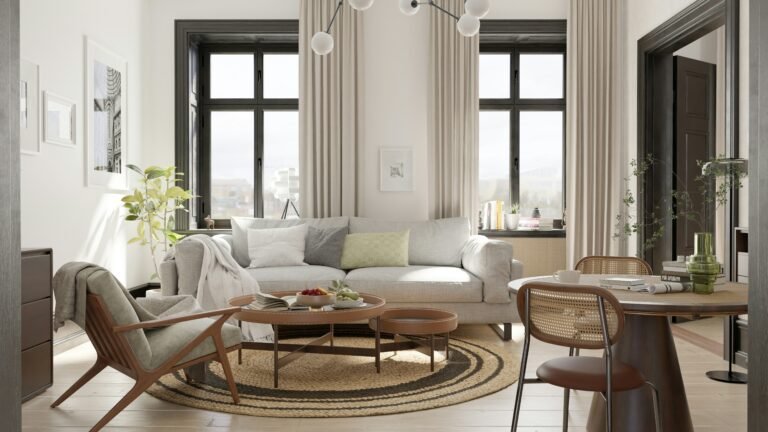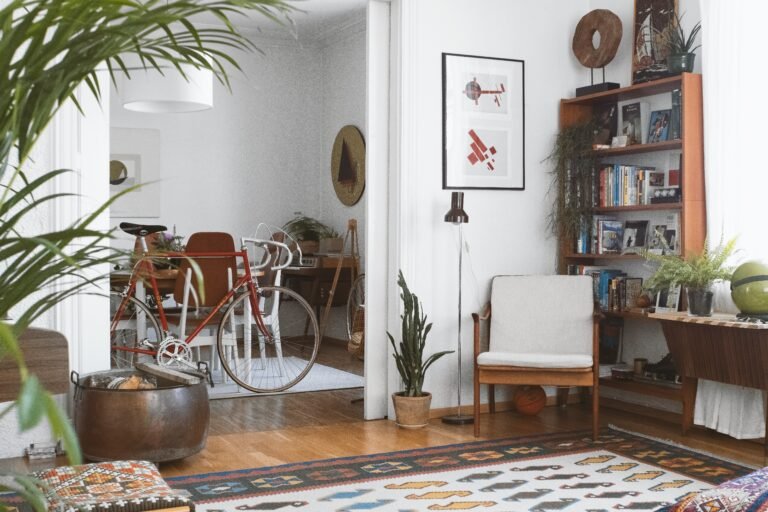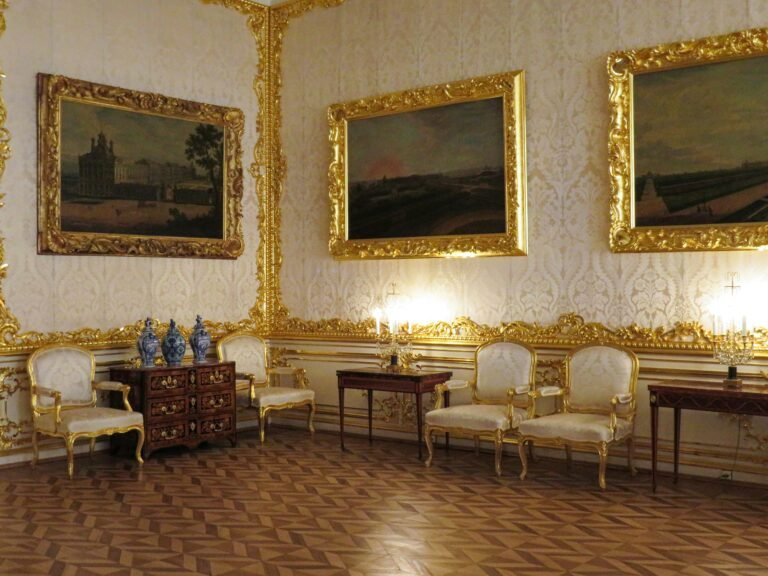When I first discovered Scandinavian interior design, I was immediately drawn to its effortless ability to make a space feel both calming and practical. The balance of clean lines, natural light, and cozy textures creates a style that feels timeless and inviting. What fascinates me most is how this design philosophy manages to combine simplicity with warmth, ensuring that homes are not only beautiful but also deeply livable.
At its core, Scandinavian style reflects the values of the Nordic countries where it was born: functionality, connection to nature, and a strong sense of comfort. It goes beyond aesthetics to embrace the idea of hygge, a Danish and Norwegian concept centered around coziness and well-being. That’s why a Scandinavian space is never just about minimalism. It’s about creating an environment where you can unwind, recharge, and enjoy life’s simple pleasures.
In this article, I’ll explore the history, principles, and modern interpretations of Scandinavian interior design. I’ll also share practical tips that you can apply to your own home to achieve the perfect balance of simplicity, comfort, and function. Whether you’re furnishing a small apartment or refreshing a family living room, this design approach has something valuable to offer.
What Is Scandinavian Interior Design
At its simplest, Scandinavian interior design is about creating homes that are beautiful without being excessive. This design style emerged in the Nordic countries during the early 20th century and became internationally recognized for its clean lines, emphasis on function, and use of natural light. Unlike styles that prioritize ornamentation, Scandinavian interiors focus on uncluttered spaces that feel calm, welcoming, and purposeful.
According to Architectural Digest, the essence of Scandinavian style lies in the harmony between functionality and beauty. You will often find rooms with neutral palettes with shades of white, beige, soft gray, paired with warm woods, natural fabrics, and plenty of daylight. This minimalist foundation makes it easier to layer in personality without overwhelming the senses.
A key part of the philosophy is hygge, a Danish and Norwegian concept that refers to comfort, coziness, and contentment. As Levtex Home explains, hygge transforms simple living spaces into sanctuaries by using soft textiles, warm lighting, and natural accents. It’s not just about how a space looks, but how it makes you feel.
When I think back to my own first encounter with Scandinavian interiors, it was through IKEA’s approachable take on the style. Their pieces captured the blend of affordability and elegance that makes Scandinavian design so popular worldwide. As Alma de Luce points out, this design language resonates because it’s democratic, it’s about creating comfort and beauty for everyday life, not just for showcase homes.
Ultimately, Scandinavian interior design is about more than minimalism. It’s a way of living that balances simplicity with comfort, ensuring that every space feels as practical as it is inviting.
The Pillars of Scandinavian Design
Every design style has its guiding principles, and Scandinavian interior design is no different. What sets it apart is how it blends simplicity, comfort, and functionality while maintaining a deep connection to nature. These four pillars are what make the style both timeless and adaptable.
Simplicity and Minimalism
At the heart of Scandinavian style is a focus on simplicity. Spaces are uncluttered, with clean lines and purposeful design. Instead of filling a room with excess furniture, the goal is to keep only what is needed and meaningful. As Apartment Guide notes, this minimalist approach ensures rooms feel open and breathable, allowing natural light to become a design element on its own. While it shares DNA with minimalism, Scandinavian interiors differ by keeping a sense of warmth and livability.
Comfort and Hygge
A defining quality of Scandinavian interiors is the concept of hygge. This is about creating spaces that feel cozy, safe, and emotionally nourishing. Think soft wool throws, layered textiles, candles, and warm wood tones. As Levtex Home explains, hygge transforms a clean space into a home that people actually want to spend time in. Personally, I’ve noticed that when I add hygge-inspired details like a sheepskin rug or a softly lit lamp guests immediately comment on how welcoming the room feels.
Functionality Above All
Another core pillar is functionality. In Scandinavian interiors, every piece of furniture has a purpose. Multi-use furniture, clever storage solutions, and designs that maximize space are central to the style. The Spruce highlights how this functionality makes the design particularly well-suited for smaller urban apartments. Instead of excess, the focus is on smart design that enhances everyday living.
Natural Materials and Light
Scandinavian countries endure long, dark winters, which makes natural light and organic materials essential to the design. Pale woods, natural fibers like linen and wool, and greenery are used to bring life and warmth indoors. Architectural Digest emphasizes that maximizing daylight with large windows, light colors, and reflective surfaces is key. This connection to nature is what keeps Scandinavian interiors feeling fresh and uplifting year-round.
Together, these pillars form the foundation of Scandinavian interior design. They explain why this style has remained globally influential: it’s not just about how a room looks, but how it supports the way we live.
Historical Roots and Evolution
To understand why Scandinavian interior design resonates so strongly today, it helps to look at its origins. The style emerged in the early 20th century in the Nordic countries – Denmark, Sweden, Norway, Finland, and Iceland as a response to a shared climate and cultural values. With long winters and limited daylight, homes were designed to maximize light, embrace functionality, and create a sense of comfort.
By the 1930s and 40s, Scandinavian style gained momentum through exhibitions that showcased its clean, modern approach. According to Architectural Digest, this period established many of the principles we associate with the style today: simplicity, affordability, and a focus on craftsmanship.
The mid-century years marked a golden age. Designers like Arne Jacobsen, best known for the iconic Egg Chair, helped shape the Danish modern movement. As Wikipedia notes, Danish modern emphasized organic shapes, natural materials, and democratic design, making beauty accessible to the everyday home. This legacy of functional yet elegant design remains central to Scandinavian interiors.
By the 1950s and 60s, the movement had spread globally, influencing architecture and interior design in the United States, Europe, and beyond. Today, brands like IKEA embody this ethos of democratic design, offering simple and functional furniture at scale. As Posh Pennies points out, this accessibility is one reason Scandinavian interiors continue to appeal across cultures.
Personally, I see this evolution as one of the reasons the style feels timeless. Unlike trends that fade, Scandinavian design has always been about practical beauty, rooted in cultural traditions that value comfort, craftsmanship, and connection to nature. That’s why even a century later, the style feels as fresh and relevant as ever.
Scandinavian Style vs Minimalism
Because Scandinavian interior design is so clean and uncluttered, it’s often confused with minimalism. While the two share similarities, there are key differences that give Scandinavian style its unique character.
Minimalism is generally about stripping a space down to its absolute essentials. It favors blank walls, stark color palettes, and very few decorative elements. As Hovia explains, minimalism is guided by the idea that less is always more, which can sometimes make interiors feel cool or even austere.
Scandinavian design, by contrast, balances minimalism with warmth and comfort. It values clean lines and functionality, but it also embraces cozy details like layered textiles, soft lighting, and natural materials. The Danish and Norwegian concept of hygge is what sets it apart. An emphasis on creating spaces that are not only efficient but also nurturing and inviting. According to DecorAI, Scandinavian interiors avoid clutter without sacrificing personality.
From my own experience, this distinction becomes clear when furnishing a room. If I lean toward minimalism alone, I risk ending up with a space that feels more like a gallery than a home. But when I add Scandinavian elements like a linen throw, a handmade ceramic vase, or a warm wood accent the room feels instantly more livable. It’s the difference between appreciating a space and actually wanting to spend time in it.
So while minimalism and Scandinavian style share a philosophy of restraint, Scandinavian design softens the edges. It’s about balance: paring down what you don’t need, while adding just enough warmth and texture to make the space comfortable and human-centered.
Contemporary Trends Scandi Maximalism and Color
While traditional Scandinavian interior design is rooted in simplicity and restraint, recent years have seen bold new interpretations emerge. One of the most fascinating evolutions is Scandi Maximalism – a trend that adds vibrant color, layered patterns, and eclectic decor while keeping the clean foundation of Scandinavian style.
According to Homes & Gardens, Scandi Maximalism is about storytelling. Instead of sticking strictly to neutrals, designers are bringing in deep blues, forest greens, or mustard yellows to create richer, more personalized interiors. The result is a look that maintains the functionality and warmth of Scandinavian design but allows for more individuality.
Even Scandinavian brands are embracing this playful shift. IKEA’s OMMJÄNGE collection introduces folklore-inspired patterns, cheerful color palettes, and whimsical motifs, demonstrating how the design philosophy can evolve without losing its essence. This proves that Scandinavian interiors don’t have to be muted, they can be vibrant while still honoring the principles of comfort and practicality.
What remains consistent, however, is the connection to natural materials. As Architectural Digest highlights, even the boldest Scandi-inspired spaces still rely on wood, wool, stone, and greenery to ground the look. Personally, I love this balance. In my own home, I’ve experimented with a pop of terracotta against pale oak floors, and the effect is both lively and soothing.
This evolution shows the adaptability of Scandinavian style. Whether stripped down to its minimalist roots or layered with color and pattern, the underlying values simplicity, comfort, and function remain at the core.
How to Implement Scandinavian Interior Design in Your Home
One of the most appealing qualities of Scandinavian interior design is how accessible it is. You don’t need a complete renovation to bring its values into your home. By making thoughtful choices in color, furniture, and materials, you can create a space that feels both modern and welcoming. Here are some practical steps to get started.
Choose a Neutral Base
Scandinavian style often begins with a light and neutral color palette. Whites, soft grays, and muted pastels create a fresh backdrop that enhances natural light. As DecorAI explains, this neutral base allows you to layer in textures and accents without overwhelming the space. If you’re unsure where to begin, start with white walls and pale wood floors, they instantly brighten a room.
Layer in Textures for Hygge
To avoid sterility, texture is essential. Soft wool throws, knitted cushions, sheepskin rugs, and linen curtains bring depth and warmth. According to Better Homes & Gardens, these layered textiles embody hygge by creating a sense of comfort and relaxation. Personally, I find that adding a chunky knit blanket over a sofa transforms the room, making it instantly more inviting.
Opt for Functional Furniture
Scandinavian interiors prioritize function. Look for furniture that serves multiple purposes like storage beds, nesting tables, or modular shelving. Clean lines and craftsmanship matter more than ornate detailing. As Levtex Home notes, the goal is to simplify living without sacrificing usability. Choosing well-made pieces also supports sustainability, a value deeply tied to Scandinavian style.
Maximize Natural Light
In northern Europe, maximizing daylight is a necessity, and the same principle applies anywhere. Large windows, sheer curtains, and light-reflecting surfaces like mirrors help open up a room. Architectural Digest emphasizes that natural light is one of the most defining features of Scandinavian interiors. If your home lacks big windows, try using pale wall colors and reflective accents to create a brighter effect.
Add Natural Materials and Greenery
Wood, stone, wool, and leather are staples in Scandinavian design. They not only provide texture but also connect your space to nature. Indoor plants are another great way to reinforce this connection. As The Spruce points out, greenery adds life and vibrancy without disrupting the clean aesthetic. In my own home, I’ve placed a fiddle-leaf fig in a simple clay pot, it brings a refreshing organic feel to the living room.
Curate Decor with Intention
Unlike maximalist styles, Scandinavian interiors rely on fewer but more meaningful objects. Instead of filling shelves with dozens of items, curate decor that reflects your personality like a handmade ceramic vase, a framed photograph, or a stack of well-loved books. This aligns with the Scandinavian belief in quality over quantity. As Alma de Luce notes, intentional decoration creates harmony without clutter.
Bring It All Together
The magic of Scandinavian style lies in balance. A neutral base sets the stage, texture adds comfort, functionality ensures practicality, and natural materials ground the design. When combined, these elements transform even the smallest apartment into a calming and efficient space. The beauty is that you can start small – add a textured rug, switch to sheer curtains, or bring in a few natural wood pieces and build from there.
My Take Bringing Scandinavian Interior Design into My Space
When I first began experimenting with Scandinavian interior design in my own home, I quickly realized how powerful small changes could be. I didn’t overhaul everything at once. Instead, I started with the basics: a neutral palette, a simple wood dining table, and soft linen curtains to maximize natural light. The effect was immediate. My living space felt brighter, calmer, and more open.
What surprised me most was how much comfort came from adding textures. A wool throw draped over the sofa and a sheepskin rug by the bed transformed my home into a space I wanted to linger in. It reminded me that design isn’t just about what looks good, it’s about how a room makes you feel. That’s where the Scandinavian idea of hygge really resonates with me.
Functionality also played a role. Choosing furniture with hidden storage kept clutter under control without sacrificing style. I found that when every piece served a purpose, my rooms felt more intentional and organized.
For me, Scandinavian style isn’t just a look, it’s a way of shaping my home so that it supports everyday life. It makes simplicity feel rich, comfort feel intentional, and function feel beautiful.
Conclusion
At its heart, Scandinavian interior design is a philosophy that blends simplicity, comfort, and function into every corner of the home. From its early roots in the Nordic countries to its global influence today, it has always been about more than just aesthetics. The balance of clean lines, natural light, and functional design creates spaces that feel timeless and practical, while the warmth of hygge makes them inviting and personal.
What I love most about this style is how accessible it is. You don’t need a massive budget or a complete remodel to capture its essence. A neutral base, layered textures, and a few thoughtful furniture choices can completely transform how a room looks and feels. It’s proof that great design doesn’t come from excess but from intention.
For me, embracing Scandinavian principles has changed how I view my living space. It’s no longer just about decorating a room but about creating an environment where I can recharge, find comfort, and live with clarity.
If you’re seeking a style that’s as gentle on the senses as it is functional in daily life, Scandinavian design offers the perfect balance. It’s a way to make your home both beautiful and deeply livable.
Frequently Asked Questions About Scandinavian Interior Design
Alex is the creator of Homely Haven, a space dedicated to simple, stylish ideas for interiors and gardens alike. With a passion for cozy living rooms, inviting outdoor spaces, and practical DIY solutions, Alex shares tips and guides that help turn any house into a true home.
From budget-friendly decorating hacks to weekend garden projects, the goal is always the same: to inspire you to create spaces that feel personal, beautiful, and welcoming. When not writing, Alex is usually rearranging furniture, sketching new garden layouts, or exploring design trends for the next project.








